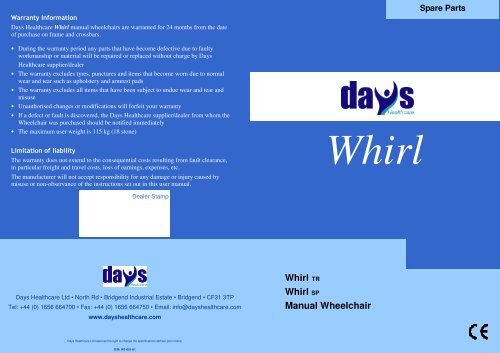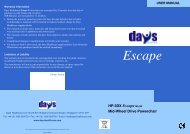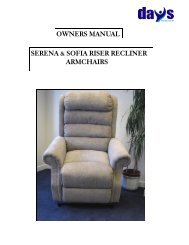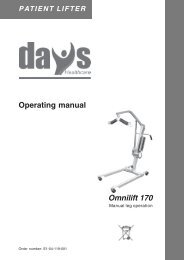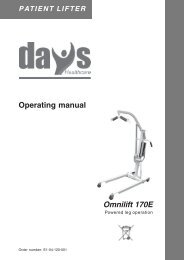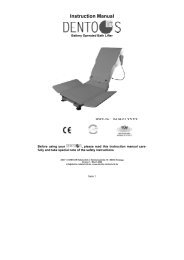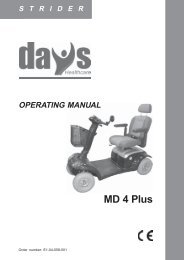Instruction Manual - Days Healthcare
Instruction Manual - Days Healthcare
Instruction Manual - Days Healthcare
You also want an ePaper? Increase the reach of your titles
YUMPU automatically turns print PDFs into web optimized ePapers that Google loves.
<strong>Days</strong> <strong>Healthcare</strong> Whirl Wheelchair<br />
Warranty Information<br />
User <strong>Manual</strong><br />
<strong>Days</strong> <strong>Healthcare</strong> Whirl manual wheelchairs are warranted for 24 months from the date<br />
of purchase on frame and crossbars.<br />
• During the warranty period any parts that have become defective due to faulty<br />
workmanship or material will be repaired or replaced without charge by <strong>Days</strong><br />
<strong>Healthcare</strong> supplier/dealer<br />
• The warranty excludes tyres, punctures and items that become worn due to normal<br />
wear and tear such as upholstery and armrest pads<br />
• The warranty excludes all items that have been subject to undue wear and tear and<br />
misuse<br />
• Unauthorised changes or modifications will forfeit your warranty<br />
• If a defect or fault is discovered, the <strong>Days</strong> <strong>Healthcare</strong> supplier/dealer from whom the<br />
Wheelchair was purchased should be notified immediately<br />
• The maximum user weight is 115 kg (18 stone)<br />
Limitation of liability<br />
The warranty does not extend to the consequential costs resulting from fault clearance,<br />
in particular freight and travel costs, loss of earnings, expenses, etc.<br />
The manufacturer will not accept responsibility for any damage or injury caused by<br />
misuse or non-observance of the instructions set out in this user manual.<br />
Whirl<br />
Spare Parts<br />
Dealer Stamp<br />
Whirl TR<br />
<strong>Days</strong> <strong>Healthcare</strong> Ltd • North Rd • Bridgend Industrial Estate • Bridgend • CF31 3TP<br />
Tel: +44 (0) 1656 664700 • Fax: +44 (0) 1656 664750 • Email: info@dayshealthcare.com<br />
www.dayshealthcare.com<br />
Whirl SP<br />
<strong>Manual</strong> Wheelchair<br />
<strong>Days</strong> <strong>Healthcare</strong> Ltd reserves the right to change the specifications without prior notice.<br />
D/N: W1-051-01
<strong>Days</strong> <strong>Healthcare</strong> Whirl Wheelchair<br />
User <strong>Manual</strong><br />
Technical Specifications<br />
Basis Material<br />
Steel frame with single hole for 12" wheel only<br />
Steel cross brace<br />
Composite cross brace link<br />
Steel backrest post<br />
Seat Parameters<br />
Seat height - front (from ground w/o cushion)<br />
Seat height - rear (from ground w/o cushion)<br />
Seat Width<br />
<br />
Seat Depth<br />
Seat angle<br />
Backrest Height (from seat w/o cushion)<br />
Angle fix backrest<br />
Transit<br />
500±5mm<br />
475±5mm<br />
380, 410, 430, 450mm (same cross brace link)<br />
480mm<br />
430mm<br />
3~4 deg<br />
440mm<br />
Folding back, 90 deg. seatplan,<br />
lumbal 8 deg. @ halfway<br />
Detachable, fixed by handwheel<br />
Legrest<br />
Footrest angle<br />
Swing out , removable<br />
65 deg.<br />
Foot plate 380,410<br />
440,450, 480<br />
Leg adjustment<br />
Footplate<br />
Overall Dimensions<br />
overall length<br />
overall width<br />
User weight<br />
Armrest<br />
Armrest ht. (from seat w/o cushion)<br />
Foam pad length<br />
Foam pad width<br />
Front castor wheel size & type<br />
Front castor wheel<br />
420~500mm<br />
Composite, fixed<br />
1110mm max<br />
600mm max<br />
115kg<br />
Detachable, Bio compatibility test comply PU<br />
220mm<br />
200mm<br />
TBD<br />
8x1<br />
PA ring, TPR tyre<br />
Rear wheel size & type 12" x 2" , Flat free, PU<br />
Rear wheel axle<br />
Rear wheel frame mounting<br />
Seat upholstery<br />
Fixed<br />
Steel sleeve welded on frame<br />
380, 410, 430, 450, 480mm
<strong>Days</strong> <strong>Healthcare</strong> Whirl Wheelchair<br />
User <strong>Manual</strong><br />
Technical Specifications<br />
Basis Material<br />
Seat Parameters<br />
Seat height - front (from ground w/o cushion)<br />
Seat height - rear (from ground w/o cushion)<br />
Seat Width<br />
<br />
Steel side frame with single hole for 24" wheel<br />
only<br />
Steel cross brace<br />
Composite cross brace link<br />
Steel backrest post<br />
Self Propel<br />
500±5mm<br />
475±5mm<br />
380, 410, 430, 450mm (same cross brace link)<br />
480mm<br />
Table of Contents<br />
Introduction 4 <strong>Manual</strong> Brake 9<br />
Intended Use 4 Folding Back 9<br />
Technical Description 4 Folding the Chair 9<br />
Feature Guide 5 Unfolding the Chair 10<br />
Safety Guidelines 6 Removal of Rear Wheels 10<br />
Safe Operation 7 Fitting Rear Wheels 10<br />
Seat Depth<br />
Seat angle<br />
Backrest Height (from seat w/o cushion)<br />
Angle fix backrest<br />
Legrest<br />
Footrest angle<br />
430mm<br />
3~4 deg<br />
440mm<br />
Folding back, 90 deg. seatplan,<br />
lumbal 8 deg. @ halfway<br />
Detachable, fixed by handwheel<br />
Swing out , removable<br />
65 deg.<br />
Foot plate 380,410<br />
440,450, 480<br />
Leg adjustment<br />
Footplate<br />
Overall Dimensions<br />
overall length<br />
overall width<br />
User weight<br />
Armrest<br />
Armrest ht. (from seat w/o cushion)<br />
Foam pad length<br />
Foam pad width<br />
Front castor wheel size & type<br />
Front castor wheel<br />
420~500mm<br />
Composite, fixed<br />
1150 max<br />
640mm max<br />
115kg<br />
Detachable, Bio compatibility test comply PU<br />
220mm<br />
200mm<br />
TBD<br />
8x1<br />
PA ring, TPR tyre<br />
Rear wheel size & type 24" x 1 3/8" Flat free, PU<br />
Rear wheel axle<br />
Rear wheel frame mounting<br />
Seat upholstery<br />
QR as std<br />
Steel sleeve welded on frame<br />
380, 410, 430, 450, 480mm<br />
Adjustment Procedures 8 Basic Propulsion 10<br />
Footrest Adjustments 8 Transferring to and from the Chair 11<br />
Heel and Calf Straps 8 Tyres 11<br />
Backrest Height 8 Slopes & Gradients 11<br />
Seat Belt 8 Transportation 12<br />
Anti-tippers 8 Maintenance Inspection 13<br />
Operations of Use 9 Cleaning 13<br />
Footrests 9 Technical Specifications 14<br />
Armrests 9<br />
- 14 -<br />
- 3 -
<strong>Days</strong> <strong>Healthcare</strong> Whirl Wheelchair<br />
User <strong>Manual</strong><br />
Introduction<br />
Welcome to the <strong>Days</strong> <strong>Healthcare</strong> Whirl manual wheelchair and thank you<br />
for choosing our product. This latest model has been designed with<br />
specific practical user needs in mind. It combines solid, rugged<br />
construction, safety and performance. We are confident that it will prove a<br />
reliable companion in your home as well as outdoors.<br />
This manual contains some useful tips and information on safety,<br />
operation and maintenance. Please read it carefully to ensure that you get<br />
maximum enjoyment and benefit from your new independence and<br />
mobility.<br />
Whenever you require special advice and attention do not hesitate to<br />
contact your local <strong>Days</strong> <strong>Healthcare</strong> dealer. He has all the equipment and<br />
know-how to provide an expert service and assistance on technical and<br />
clinical applications to suit your particular need.<br />
Maintenance & Inspection<br />
We recommend that your wheelchair is serviced by your local dealer every<br />
twelve months. It is in your best interests, not only to ensure your personal safety<br />
but also to ensure long life and reliability. Regular service will identify early<br />
damage and worn components avoiding unnecessary faults occurring.<br />
Weekly check that:<br />
• <strong>Manual</strong> brakes do not rub the tyres and secure the wheel when locked<br />
• Castor bolts are tight and all fasteners are secure<br />
• Arms operate and lock securely in front of rear sockets<br />
• The drive wheels axles are secure and there is no excessive side movement or<br />
binding when spun<br />
• Tyres do not show excessive wear or damage<br />
• Castors for proper tension, i.e. spinning castors should come to gradual stop<br />
Intended Use<br />
The Whirl manual wheelchairs are intended to assist and improve<br />
mobility for those individuals who are less able or have walking difficulties<br />
who wish to maintain their independence and freedom.<br />
Your day to day activities will depend on your physical capabilities and<br />
your own specific circumstances. If in doubt seek medical advice first.<br />
The information is this booklet provides a general guide on how to use<br />
your chair safely and correctly. Do not use the chair without reading this<br />
manual first.<br />
Technical Description<br />
The <strong>Days</strong> <strong>Healthcare</strong> Whirl manual wheelchair has a maximum carrying<br />
capacity of 115 kg (18 stone) which must never be exceeded.<br />
It is classified as an ‘Invalid Carriage’ for use indoors, on pavements,<br />
footpaths, pedestrian zones and areas free from motor traffic. Use on the<br />
road or highway is not allowed except for the purpose of crossing.<br />
Monthly check that:<br />
• Tyres are not excessively worn<br />
• Handrims do not have sharp edges or any abrasion<br />
• The chair rolls straight (no excessive drag or pull to one side)<br />
• Pivot points are free of wear or looseness<br />
• Seat and backrest upholstery is not for ripped or sagging<br />
• Frames are not worn or bent<br />
Cleaning<br />
Paintwork and plastic mouldings can be cleaned with a damp soft cloth of warm<br />
soapy water. Do not use any harsh abrasive cleaners, bleach base fluids or<br />
solvents.<br />
Seat and back upholstery can be cleaned with a general purpose upholstery<br />
cleaner or sponged with warm soapy water.<br />
- 4 -<br />
- 13 -
<strong>Days</strong> <strong>Healthcare</strong> Whirl Wheelchair<br />
User <strong>Manual</strong><br />
Transportation<br />
We recommend that you do not sit on your Wheelchair when in a vehicle, but<br />
transfer to a vehicle seat. A Wheelchair secured in a vehicle will not provide the<br />
equivalent safety level and security as the vehicle’s seating systems.<br />
However, when transfer is not practical or impossible, ensure the following:<br />
1) Check that the vehicle is suitably designed, insured and equipped to transport<br />
a passenger seated in a Wheelchair<br />
2) Remove any part of the Wheelchair (accessories, etc.) that can be easily detached<br />
and store it in the vehicle’s luggage hold<br />
3) Make sure the Wheelchair is transported in a forward facing direction. Rearward<br />
facing is only acceptable if the passenger’s head and back can be supported by a<br />
suitable bulkhead<br />
4) Use the buckle seat belt (if fitted) with your chair as additional restraint<br />
Feature Guide<br />
Whirl TR<br />
Armrest<br />
Footrest<br />
Folding Back<br />
<strong>Manual</strong> Brake<br />
Footplate<br />
Front Castor<br />
Transit Wheel<br />
Whirl SP<br />
Folding Back<br />
We recommend that the wheelchair is secured within the vehicle using the 4-<br />
point webbing tie-down system with Karibiner, model no WWR/ATF/K/R<br />
(available from Unwin Safety Systems based in Yeovil, U.K.)<br />
Note: Although safety during transportation largely depends upon the diligence<br />
of the person securing the tie-downs and passenger restraints it is the user’s responsibility<br />
to ensure that the wheelchair has been safely secured.<br />
Armrest<br />
Footrest<br />
Footplate<br />
Front Castor<br />
Self-propelled Wheel<br />
Hand rim<br />
- 12 -<br />
- 5 -
<strong>Days</strong> <strong>Healthcare</strong> Whirl Wheelchair<br />
User <strong>Manual</strong><br />
Safety Guidelines<br />
Do not use on the road, except when crossing between pavements.<br />
When crossing the carriageway of a public road always take extra care<br />
and observe the Highway code<br />
Do not ride over deep, soft terrain (soft dirt, loose gravel, deep grass)<br />
Do not attempt to mount a kerb without assistance<br />
Do not carry passengers<br />
We recommend that you do not sit on your wheelchair when in a<br />
vehicle, but transfer to a vehicle seat<br />
Always engage a slow speed when going down gradients<br />
Do not ride in reverse down a slope or kerb<br />
Always keep your feet on the footplate when moving<br />
Do not stand on the footplate when getting in or out of the chair<br />
We recommend the use of safety belt<br />
Always keep your pneumatic tyres to the correct pressures<br />
Do not use parts, accessories or adapters other then those authorised<br />
by <strong>Days</strong> <strong>Healthcare</strong> Ltd<br />
Keep the wheelchair away from children. It is not intended to be used<br />
as a toy<br />
The manual parking brakes are not designed for slowing-down<br />
Rear Wheel Setup<br />
Anti-tippers can be retro fitted as an option if required by the user.<br />
Transferring to and from the Chair<br />
Circumstances and individual needs will vary from person to person, but if there<br />
are difficulties we advise you to consult your therapeutic advisor who will help<br />
you to develop your skill for appropriate transfer method that suits you.<br />
During transfer always make sure that the brakes are in a locked position and the<br />
wheelchair is manoeuvred as close as possible to the transfer seat<br />
Tyres<br />
Regularly check the condition of front & rear tyres for wear and tear. Contact<br />
your supplier for replacements.<br />
If you have pneumatic tyres fitted, the pressure indicated on the side of the tyre<br />
wall should not be exceeded.<br />
Slopes and Gradients<br />
Do not attempt to climb or descend beyond your limitations<br />
to avoid tipping over.<br />
Climbing Upwards<br />
Lean the upper body forward and move the wheelchair forwards<br />
with short quick pushes on the Handrims.<br />
Downward Travel<br />
Lean backwards in the chair and let the handrim slide gently<br />
through your hands to control downward speed and direction.<br />
Note: - When travelling down or up a slope, avoid sharp<br />
turns, zigzag movements or moving across the slope<br />
BE CAREFUL<br />
- 6 -<br />
- 11 -
<strong>Days</strong> <strong>Healthcare</strong> Whirl Wheelchair<br />
User <strong>Manual</strong><br />
Unfolding the Chair<br />
When both wheels have been secured, grasp both side frames of the wheelchair<br />
and pull apart as far as possible or at least until there is sufficient room to push<br />
down on the sides of the seat canvas.<br />
The chair is fully open when the seat canvas is taut and flat.<br />
Place the seat cushion on top of the canvas with the angled edge towards the front<br />
of the chair. Note that Velcro holds this in place.<br />
Removal of Rear Wheels (Self-propelled Model)<br />
The rear wheels are removed by depressing the pin at the centre of the wheel hub<br />
and withdrawing the wheel.<br />
Safe Operation<br />
When using indoors beware of narrow doors, steps, high surfaces,<br />
protruding wall fittings and everyday household items such as children’s<br />
toys, electrical appliances etc. Take extra care in kitchen environments.<br />
To ensure stability and safe control you must maintain proper balance at<br />
all times. The wheelchair is designed to remain stable during normal use<br />
as long as you do not move you centre of gravity outside the normal<br />
seating position.<br />
When reaching/bending forward do not lean your body out of the wheelchair<br />
further than the length of the armrests. Do not attempt to reach objects by<br />
sliding forwards to the edge of the seat.<br />
When reaching/bending backwards do not reach any further than your arm<br />
will extend without changing your seating position.<br />
Never attempt to use an escalator or stairway, always use a lift.<br />
Occasionally check that the adjustments of the footrests, armrests and<br />
controller are secure and are set in the most comfortable position for use.<br />
Fitting Rear Wheels (Self-propelled Model)<br />
The Whirl wheelchair SP is fitted with quick release rear<br />
wheels. It is important to ensure that wheels are correctly<br />
fitted to avoid accidents.<br />
To fit rear wheels depress rubber cover at the centre of the<br />
wheel hub and push the wheel spindle firmly into the axle<br />
bush, ensuring that both ball bearings are fully exposed<br />
beyond the axle bush.<br />
Once located, test the wheel for security by pulling the wheel firmly in an attempt<br />
to remove it without depressing the rubber cover.<br />
Basic Propulsion<br />
To move forwards or backwards, the user should release the brakes, grasp the<br />
handrims (attached to rear wheels) and with a pushing action rotate them<br />
forwards or pull them backwards respectively.<br />
To move to the right, hold the right handrim steady and push forward with the<br />
left handrim. To move to the left, hold the left handrim steady and push forward<br />
the right handrim.<br />
- 10 -<br />
- 7 -
<strong>Days</strong> <strong>Healthcare</strong> Whirl Wheelchair<br />
User <strong>Manual</strong><br />
Adjustment Procedures<br />
Swing-away Footrest<br />
Length Adjustment<br />
Adjustments are made with the user sitting in the<br />
wheelchair with feet on footplates.<br />
1) Use a spanner to loosen the bolt at the rear of the<br />
footrest support hanger.<br />
2) Adjust the footplate up or down as needed to provide<br />
maximum support of thighs on the seat upholstery, then re-tighten the bolt.<br />
WARNING!<br />
Ensure that desired front rigging adjustment does not cause pressure to legs<br />
at front of seat upholstery.<br />
Operations of Use<br />
Footrests<br />
Your footrests are capable of being rotating outwards. To achieve this pull the<br />
release lever towards you and rotate footrest in the required direction. Lift-off<br />
from the two pivot points to remove.<br />
Armrests (Detachable type)<br />
Both armrests are removable. To operate, push the release lever in to<br />
unclip and lift arm out of front socket and rear sockets.<br />
Heel and Calf Straps (if fitted)<br />
Your wheelchair is equipped with heel straps which are secured on the footplates<br />
or calf straps which are attached on the footrest support tubes. The calf straps are<br />
tension adjustable with the aid of Velcro.<br />
<strong>Manual</strong> Brake<br />
This is a parking brake which is applied manually to the tyres when the chair is<br />
parked or stationary. To apply the brake, push the lever forwards until the shoe is<br />
locked in place. Pull backwards to release.<br />
Seat Belt (if fitted)<br />
Hold the bayonet end in one hand, and pull on the webbing to increase or decrease<br />
belt length with the other. When length is correct, adjust slide buckle to<br />
suit.<br />
Anti-tippers (if fitted)<br />
These are fitted at the rear of the chair, adjacent to the rear wheels and <strong>Days</strong> recommends<br />
that these are fitted, especially when climbing kerbs and gradients.<br />
Folding Back<br />
This is available to reduce the overall height of the chair. Whilst at the rear of the<br />
chair, grip the small lever and push down to release pin allowing the handle section<br />
to be folded.<br />
Folding the Chair<br />
Remove the seat cushion. The wheelchair is folded by grasping<br />
the seat canvas at the front centre with one hand and at the rear<br />
with the other. A simple lifting action will draw both sides of<br />
the chair together into the folded position.<br />
- 8 -<br />
- 9 -


